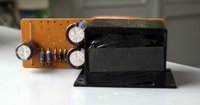 These are the step-by-step guidelines for upgrading the Quad 33 amplifier to modern high-end standards.
These are the step-by-step guidelines for upgrading the Quad 33 amplifier to modern high-end standards.You can order the components from your local dealer or you can use the 33 upgrade-kit available via www.dadaelectronics.eu or via the Ebay webshop - Objectnumber 200014330586.
All resistances are Metalfilm low-noise 1% and all capacitors are Audio-grade (except in the power-supply) and 25 Volt or more.
Watch the polarity of all diodes & electrolyt capacitors!
If you need a (free) copy of the schematics or the service-manual, send an e-mail to info@dadaelectronics.eu. You can also get 7/7 technical support about upgrading the 33 via this e-mail.
Step 1 - Modifying the power-supply from 11 to 16 Volt
 Increasing the power-supply voltage to 16V makes the pre-amp more stable. The reason why Quad used an 11 Volt power-supply was the size of the capacitors at the time the 33 was designed.
Increasing the power-supply voltage to 16V makes the pre-amp more stable. The reason why Quad used an 11 Volt power-supply was the size of the capacitors at the time the 33 was designed.We will also remove the 5V line on pin 4 of the output that was intended for switching on the power-amplifier but that was never used with the Quad power-amps.
- Desolder the wire-beam and the mains-connections on the power-supply board. Remove the power-supply board (2 screws holding the transformer flanges). Remove all components except the transformer from the board.
- Replace R500 and R501 with 27R resistances
- Replace MR500 with a 1,3W 16 Zener
- Replace MR501 & MR502 with 1N4004
- Replace C500 & C501 with 4700MF. Mount them pretty flush so you can still access the screw hole in the transformer flange
- Replace C502 with 1000MF axial
- Remove R502, MR503, C503 & C504

Watch the polarities. The 3 diodes have the Katode (the black band) to the center of the board. C500 and C501 have the - on the topside and C502 has the + on the topside.
Those 2 electrolyt caps are old and have dried out.
